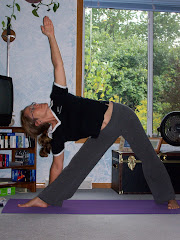
If you have pain due to SI misalignment, try the follow exercises. I learned these last year from Doug Keller of Do Yoga. He is an amazing teacher filled with great wisdom and knowledge. If you ever have a chance to study with him, I highly recommend it :-) Please, remember this is my interpretation of what he said and has worked well when I've used it. However, these are not Doug's exact words.
Steps to healing from a misaligned SI involve:
1. Adjust the sacrum back into alignment
2. Tone the area to keep it aligned

Supine with bent knees and rock side to side. Cross your legs close together and rock. Swap sides. One side of the sacrum (if misaligned) will feel more "pokey".


Lengthen the leg on the "pokey" side out long and hold the opposite knee in. Bounce the straight leg up and down, keeping it off of the floor. Now slide the straight leg (still off of the floor) to the same side until the body begins to tip. Do this a few times. Only if neither side felt "pokey" and you feel no misalignment, then do both sides.
Another way to feel if one side is poking out, is to flatten the low back into the floor and feel the top of the sacrum.


To continue adjusting the sacrum, come into set bandhasana (bridge) with a block support just below the waistline. Using 2 wide blocks stacked on top of each other seems to work pretty well. Now bend the knees and place the feet on a wall or even straight up.
With all of this said, low back pain is frequently associated with stress, especially when dealing with money or security of any kind. Pay attention and notice when "spasms" occur.
In the past, I have dealt with back pain and had found that some was due to scoliosis, some a new hard bed, and some fear of not having enough money. It's only when I was able to address all 3 that healing began in earnest.
Best of luck to you,
Love,
Kris
http://www.totalhealthyoga.com/




11 comments:
Great entry, Kris - this really is a common injury. I agree, get things back in, then get them toned. Most yoginis get way too bandy, then problems arise.
Thank you so much-I have been in pain in for so long-I can now sleep at night-and have free range of motion
Paige
I am thrilled that the info helped you!! Thank you so much for letting me know. Just last night we were talking in class about how complex back problems can be and they are so different for each of us. I was beginning to really question if the info that I've learned is helping anyone, because I know it doesn't help everyone.
So, thanks for letting me know -- that's what keeps me going :-)
I actually had a SI injury last night in my kundalini yoga class. During a pose I hyperextended my low back, unfortunately past my limit. I was trying to breath into a stretch but I was too stiff in my hips from being on my feet all day, so it was also stressful in my SI joint. It happened a couple poses into class (there was still 1 hour left), but I didn't want to leave and have to miss my favorite yoga class (and admit to my teacher I just stretched too far). So I just did the breathing in whatever modification of the pose I could do. I found myself bringing my legs to my chest, like the stretch you show, and also I kept comfortable by doing some lower trunk rotations. I was also able to do a light pedaling motion with my legs up off the ground while laying down. Besides those positions, I was in intense pain on one side of my low back. I had difficulty and pain rolling from my stomach to my back. Luckily, I have learned a bit about the body at my job as an aide at a physical therapy clinic. I iced before bed when I got home, and in the morning when I was at work I started looking through the anatomy books to figure out what muscle I had sent into a spasm. After talking about it with one of the physical therapists, I realized that I had caused trauma to my SI joint and now the muscles around it were spasming. So, it was interesting to read your blog now that I am home from work and looking on the internet to understand more about the SI joint. The PT I spoke to did a strain-counter strain technique on my high SI area, which involves positioning the body in a way that allows the muscles above the SI joint to shorten. You can self-treat in this way by laying on your stomach, head resting on hands of bent arms, and propping your thigh to foot up on pillows (in a position where your leg can relax without causing pain). Your foot should lie externally rotated away from you , and your whole leg should be slightly abducted, or spread apart at an angle from your other leg. It is important that you find a position where you feel no or at most minuscule pain in your back, while being able to completely relax your leg and glute muscles in the propped position. This will release the muscles and allow the SI joint to settle back into alignment. Even though it is a PT treatment, it reminds me a lot of yoga, especially when you get into the position and you have to use your breathing to relax your muscles. I plan to do that if pain increases, but since it was adjusted this afternoon I plan on alternating heat and ice and doing more of those yoga stretches that eased the spasm last night. I was going to move into a new apartment this weekend and I am a potter, so I was planning on using my back a lot this weekend...so it should be interesting to see how soon my back can feel better. Thanks for publishing your article!
-Kate
Thank you so much for this post! I did as you suggested last night and IMMEDIATELY felt relief! This morning I am pain- free. I cannot thank you enough!
How wonderful! Thanks for sharing your experience.
I have a chronic SI injury and I tried this technique today - it worked! Thank you so much, Kris! I just have one question, how high are the blocks off the ground? I don't have yoga blocks, so I'm using books, and I've got them stacked up about 10" high. How do I know how high I should go? As high as the bridge pose will allow for clearance? Thanks again! Hank
Hank,
I'd say that if it's working for you, then the height you have is perfect the way you have it. I happen to use 8" (two 4" blocks), but I'm a short person. I really depends on how tall you are, how flexible you are, and what's comfortable for your body. Again, if it's working--stick with what you've got!
Thanks for letting me know you're having luck.
Take care,
Kris K
A couple things. This "pokey" feeling; is this a sensation we should feel or something we should be able to notice through touch?
Also, what exercises would you recommend to "tone" this area? Thanks!
Hi Adam,
Basically what can happen is the sacrum can slip in front of or behind the illium (what some folks think of as their "hip bone"). If one side hurts that's the side to focus on. Sometimes you will be able to feel this side push or poke into the ground with you lay supine (on your back). When in doubt, just do both sides.
As for toning this area, I'd recommend (as long as you have no other issues going on to contraindicate these poses) Cobra with legs held various distances apart, Locust with legs opening and closing in the upright position, and finally some supine with legs in Bound Angle (baddha konasana)then take several breaths to very slowly bring knees together. You'd have to add some low back releasing and warm ups to this as well--consult a local yoga teacher and have them help you out with the details.
Thanks for the reply Kris.
Post a Comment